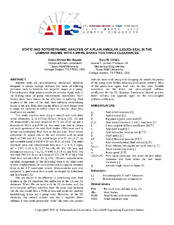| dc.description.abstract | Annular seals are non-contacting mechanical elements designed to reduce leakage between two areas of differing pressures such as between two impeller stages in a pump. Circumferential fluid rotation inside the annular liquid seals is the leading cause of pump rotordynamic instabilities. Swirl brakes have been shown to be effective in reducing fluid rotation at the inlet of the seal; thus reducing destabilizing forces in the seal. Data showing the effects of swirl brakes over a range of clearance-to-radius ratios in laminar fluid flow conditions are needed. This study involves tests using a smooth seal with three radial clearances ???? = 127?m, 254?m, 381?m (1X, 2X and 3X respectively), an axial length of 45.72 mm (1.80 in) and a diameter of 101.6 mm (4.00 in). An insert was used to induce pre-swirl upstream of the seal. Swirl brakes (SBs) were used to reduce circumferential fluid flow at the seal inlet. Swirl brakes comprised 36 square cuts at the seal entrance with an axial depth of 5.08 mm (0.2 in), radial height of 6.35 mm (0.25 in) and circumferential width of 6.35 mm (0.25 in) each. The study produced static and rotordynamic data at ?? = 2, 4, 6, 8 krpm, ??? = 2.07, 4.14, 6.21, 8.27 bar (30, 60, 90, 120 psi), and eccentricity ratios ??0 = ??0????? = 0.00, 0.27, 0.53, and 0.80. The test used ISO VG 46 oil at a range of 115-120 ? to keep f the fluid flow laminar (Total ???? ? 650). Dynamic measurements included components of the following vectors (a) stator-rotor relative displacements, (b) acceleration and (c) applied dynamic force in the ??-?? coordinate system. Measurements were also compared to predictions from a code developed by Zirkelback and San Andrés [1]. SBs are shown to be effective in minimizing inlet fluid rotation at the 3X clearance but ineffective at the 1X and 2X clearance. When SBs are used with the 3X clearance seal, the cross-coupled stiffness variables have the same sign meaning that the seal would have a WFR of zero and would not produce destabilizing forces on a pump rotor. However, at the 3X clearance, the smooth annular seal has a negative direct stiffness ?? that could potentially “suck” the rotor into contact with the stator wall, along with dropping the natural frequency of the pump rotor, further reducing its dynamic stability. Most of the predictions agree well with the test data. Notable exceptions are the direct and cross-coupled stiffness coefficients for the 3X clearance. Predictions showed positive direct stiffness and opposite signs for the cross-coupled stiffness coefficients. | en |


